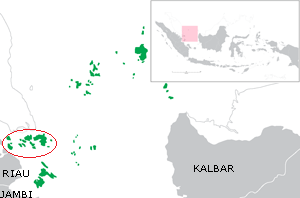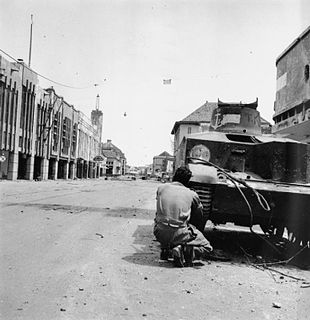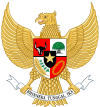
The Indonesian National Revolution, or the Indonesian War of Independence, was an armed conflict and diplomatic struggle between the Republic of Indonesia and the Dutch Empire and an internal social revolution during postwar and postcolonial Indonesia. It took place between Indonesia's declaration of independence in 1945 and the Netherlands' transfer of sovereignty over the Dutch East Indies to the Republic of the United States of Indonesia at the end of 1949.

The Riau Islands is a province of Indonesia. It comprises a total of 1,796 islands scattered between Sumatra, Malay Peninsula, and Borneo including the Riau Archipelago. Situated on one of the world's busiest shipping lanes along the Malacca Strait and the South China Sea, the province shares water borders with neighboring countries such as Singapore, Malaysia, and Brunei. The Riau Islands also has a relatively large potential of mineral resources, energy, as well as marine resources. The capital of the province is Tanjung Pinang and the largest city is Batam.

The Riau Archipelago is a geographic term for the core group of islands within the Riau Islands Province in Indonesia, and located south of Singapore and east of Riau on Sumatra. Before the province of Riau Islands was formed, there was no ambiguity in term; however, in Indonesian language, both the archipelago and administrative province are referred to as simply "Kepulauan Riau". The province may have the word "Provinsi" preceding it for clarity. Additionally the term BBK for Batam Bintan Karimun may refer to the archipelago.

The Communist Party of Indonesia was a communist party in Indonesia during the mid-20th century. It was the largest non-ruling communist party in the world before its violent disbandment in 1965. The party had two million members in the 1955 elections, with 16 percent of the national vote and almost 30 percent of the vote in East Java. During most of the period immediately following independence until the eradication of the PKI in 1965, it was a legal party operating openly in the country.

Barito River is the second longest river in Borneo after the Kapuas River with a total length of 1,090 km (680 mi) and with a drainage basin of 81,675 square kilometers (31,535 sq mi) in South Kalimantan, Indonesia. It originates in the Muller Mountain Range, from where it flows southward into the Java Sea. Its most important affluent is the Martapura River, and it passes through the city of Banjarmasin.

The Empire of Japan occupied the Dutch East Indies during World War II from March 1942 until after the end of the war in September 1945. It was one of the most crucial and important periods in modern Indonesian history.

The Battle of Surabaya was fought between regular infantry and militia of the Indonesian nationalist movement and British and British Indian troops as a part of the Indonesian National Revolution against the re-imposition of Dutch colonial rule. The peak of the battle was in November 1945. The battle was the largest single battle of the revolution and became a national symbol of Indonesian resistance. Considered a heroic effort by Indonesians, the battle helped galvanise Indonesian and international support for Indonesian independence. 10 November is celebrated annually as Heroes' Day.

The State of East Indonesia was a post–World War II state formed in the eastern half of Dutch East Indies by the Netherlands. Established in December 1946, it became part of the United States of Indonesia in 1949 at the end of the Indonesian National Revolution, and was dissolved in 1950 with the end of the USI. It comprised all the islands to the east of Borneo and of Java.

Rear Admiral (Ret.) Jahja Daniel Dharma, BMP, also known as John Lie Tjeng Tjoan, a National Hero of Indonesia, was one of the first high-ranking navy commanders during the Indonesian National Revolution.

The State of East Sumatra was established by the Netherlands after the reoccupation of North Sumatra in July, 1947, during the first of the Dutch "police actions" against the fledgling Republic of Indonesia. In 1949, as part of a peace deal that concluded the Indonesian National Revolution, it joined the United States of Indonesia, of which the Republic was also a component state. In August, 1950, it was absorbed into the Republic as part of the province of North Sumatra. The area covered by the former state included the present-day regencies of Langkat, Deli Serdang, Serdang Bedagai, Karo, Simalungan, Batubara and Asahan, together with the cities geographically within those regencies.

Southeast Borneo Federation was an autonomous area formed in the southeastern part of Indonesian island of Borneo by the Netherlands in 1948 as part of an attempt to re-establish the colony of the Dutch East Indies during the Indonesian National Revolution. Southeast Borneo became a constituent part of the United States of Indonesia in 1949. The Federation was dissolved on 18 April 1950 and combined with Great Dayak and Bandjar to form South Kalimantan Province.

Tahi Bonar Simatupang was a soldier who served in the Indonesian National Revolution and went on to become chief of staff of the Indonesian Armed Forces.

The United States of Indonesia, was a short-lived federal state to which the Netherlands formally transferred sovereignty of the Dutch East Indies on 27 December 1949 following the Dutch-Indonesian Round Table Conference. This transfer ended the four-year conflict between Indonesian nationalists and the Netherlands for control of Indonesia. It lasted less than a year, before being replaced by the unitary Republic of Indonesia.

The State of Madura was a federal state (negara bagian) formed on the Indonesian island of Madura by the Netherlands in 1948 as part of an attempt to reestablish the colony of the Dutch East Indies during the Indonesian National Revolution. It included Madura and neighbouring islands that now form part of the current province of East Java.
Riau Residency was an administrative territorial entity of the Dutch East Indies.

Riau-Lingga Sultanate, also known as the Lingga-Riau Sultanate, Riau Sultanate or Lingga Sultanate was a Malay sultanate that existed from 1824 to 1911, before being dissolved following Dutch intervention.

Anepsion is a genus of orb-weaver spiders first described by Embrik Strand in 1929.

The Riouw class was a class of four steam screw gunvessels of the Royal Netherlands Navy. They were the first composite built ships of the Dutch navy.

The Central Java Region was a federal state (negara bagian) formed on the Indonesian island of Java by the Netherlands in 1949 as part of an attempt to reestablish the colony of the Dutch East Indies during the Indonesian National Revolution. It included the central part of Java island, which now forms part of the current province of Central Java.

The Bangka Region was a new land and part of the United States of Indonesia formed in the southern part of Sumatra by the Netherlands in 1947 as part of an attempt to reestablish the colony of the Dutch East Indies during the Indonesian National Revolution.




















